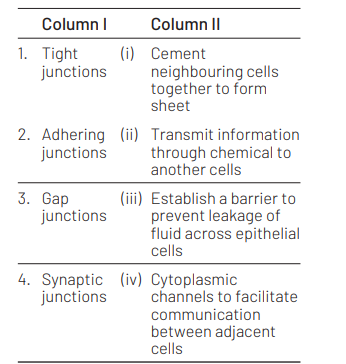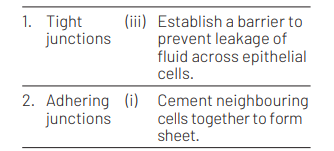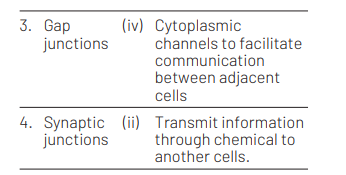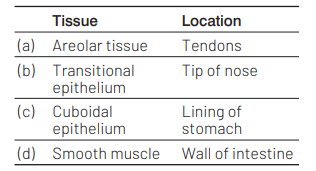Question
Identify the types of cell junctions that help to stop the leakage of the substances across a tissue and facilitation of communication with neighbouring cells via rapid transfer of ions and molecules.
[NEET 2021]
(a) Gap junctions and adhering junctions, respectively
(b) Tight junctions and gap junctions, respectively.
(c) Adhering junction and tight junctions, respectively
(d) Adhering junctions and gap junctions, respectively
Answer/Explanation
Ans. (b)
Tight junction helps to stop the leakage of the substances across a tissue and Gap junction are channels that physically connect neighbouring cells, mediating the rapid exchange of small molecules or ions.
Adhering junction They are cell-cell junction complexes that make important contribution to embryogenesis and tissue homeostasis.
Question
Goblet cells of alimentary canal are modified from [NEET (Sep.) 2020]
(a) columnar epithelial cells
(b) chondrocytes
(c) compound epithelial cells
(d) squamous epithelial cells
Answer/Explanation
Ans. (a)
Goblet cells of alimentary canal are modified from columnar epithelial cells, which secrete mucus.
These cells are found in the lining of organs like intestine and respiratory tract.
These secretes mucin (glycoprotein) and maintains the layer of mucus. As each cell secretes mucin for mucous production it is called as a unicellular mucous gland.
Question
Cuboidal epithelium with brush border of microvilli is found in [NEET (Sep.) 2020]
(a) ducts of salivary glands
(b) proximal convoluted tubule of nephron
(c) Eustachian tube
(d) lining of intestine
Answer/Explanation
Ans. (b)
Cuboidal epithelium with brush border of microvilli is found in proximal convoluted tubule of nephron. The epithelium fills the lumen, and the microvilli increases the surface area by 30-40 fold.
A brush border is a name for the microvilli-covered surface of simple cuboidal epithelium and simple columnar epithelium cells found in certain locations of the body.
The proximal convoluted tubule of the vertebrate nephron lies between Bowman’s capsule and the loop of Henle and functions especially in the absorption of sugar, sodium and chloride ions and water from the glomerular filtrate.
Question
Mach the following cell structures with their characteristic features. [NEET (Odisha) 2019]

Select the correct option from the following
1 2 3 4
(a) (ii) (iv) (i) (iii)
(b) (iv) (ii) (i) (iii)
(c) (iii) (i) (iv) (ii)
(d) (iv) (iii) (i) (ii)
Answer/Explanation
Ans. (c)
The correct matches are


Question
The ciliated epithelial cells are required to move particles or mucus in a specific direction. In humans, these cells are mainly present in [NEET (National) 2019]
(a) Fallopian tubes and pancreatic duct
(b) eustachian tube and salivary duct
(c) bronchioles and Fallopian tubes
(d) bile duct and bronchioles
Answer/Explanation
Ans. (c)
In humans, ciliated epithelial cells are present in the bronchioles and Fallopian tube. In bronchioles, these cells help in the movement of mucus and in Fallopian tube, these are required to move the egg towards uterus. On the other hand, salivary and pancreatic ducts are lined by simple cuboidal epithelium. Bile duct is lined by simple columnar epithelium and Eustachian tube is lined by columnar epithelium having ciliated cells.
Question
Which type of tissue correctly matches with its location? [NEET 2016, Phase I]

Answer/Explanation
Ans. (d)
Columnar epithelium is present in the lining of stomach.
Tendon is dense connective tissue and connects muscle to bone. Tip of nose consists of elastic cartilage.
Question
The function of the gap junction is to [CBSE AIPMT 2015]
(a) performing cementing to keep neighbouring cells together
(b) facilitate communication between adjoining cells by connecting the cytoplasm for rapid transfer of ions, small molecules and some large molecules
(c) separate two cells from each other
(d) stop substance from leaking across a tissue
Answer/Explanation
Ans. (b)
A gap junction may nexus or macula communicans. These are specialised intercellular connection between a multitude of animal cell types. They directly connect the cytoplasm of two cells, which allows various molecules, ions and electrical impulses to directly pass through a regulated gate between cells.
Question
Choose the correctly matched pair. [CBSE AIPMT 2014]
(a) Inner lining of salivary ducts-Ciliated epithelium
(b) Moist surface of buccal cavity-Glandular epithelium
(c) Tubular parts of nephrons-Cuboidal epithelium
(d) Inner surface of bronchioles-Squamous epithelium
Answer/Explanation
Ans. (c)
Cuboidal epithelium is present in the tubular parts of nephron (PCT and DCT). It consists of short, cube-shaped cells with round nuclei located in the centre of the cell. These cells often forms microvilli to increase the absorptive surface area of the cell.
Other correctly matched points are Inner lining of salivary ducts is lined by compound epithelium.
Moist surface of buccal cavity is lined by compound epithelium nner surface of bronchioles is lined by ciliated epithelium.
Question
In which one of the following preparations are you likely to come across cell junctions most frequently? [CBSE AIPMT 2007]
(a) Ciliated epithelium
(b) Thrombocytes
(c) Tendon
(d) Hyaline cartilage
Answer/Explanation
Ans. (a)
Specialised cell junctions occur at many points of cell-cell and cell matrix contact in all tissues, but they are particularly important and plentiful in epithelium.
Question
The cell junctions called tight, adhering and gap junctions are found in [CBSE AIPMT 2009]
(a) muscular tissue
(b) connective tissue
(c) epithelial tissue
(d) neural tissue
Answer/Explanation
Ans. (c)
In epithelial tissue, the adjacent cells form ion-rich gap or cell junctions for intercellular communication and chemical exchange. These junctions probably do not provide physical support.
Question
The ciliated columnar epithelial cells in humans are known to occur in [CBSE AIPMT 2011, 09]
(a) bronchioles and Fallopian tubes
(b) bile duct and oesophagus
(c) Fallopian tubes and urethra
(d) eustachian tube and stomach lining
Answer/Explanation
Ans. (a)
The columnar epithelium is composed of a single layer of tall and slender cells. If the columnar cells bear cilia on their free surface, they are called ciliated columnar epithelium. They are mainly present in the inner surface of hollow organs like bronchioles and Fallopian tubes. Their function is to move particles or mucus in a specific direction over the epithelium.
Question
The kind of epithelium which forms the inner walls of blood vessels is [CBSE AIPMT 2010]
(a) cuboidal epithelium
(b) columnar epithelium
(c) ciliated columnar epithelium
(d) squamous epithelium
Answer/Explanation
Ans. (d)
Simple squamous epithelium consists of only one layer of flat, scale like cells usually polygonal cells, which are closely fitted together like the tiles of a mosaic. It is also known as pavement epithelium. It forms lining of blood vessels, lymph vessels, heart, peritoneum, pleura, Bowman’s capsule, etc.
Question
Simple epithelium is a tissue in which the cells are [CBSE AIPMT 2000]
(a) hardened and provide support to the organ
(b) cemented directly to one another to form a single layer
(c) continuously dividing to provide form to an organ
(d) loosely connected to one another to form an irregular organ
Answer/Explanation
Ans. (b)
Simple epithelium is a tissue in which the cells are cemented directly to one another to form a single layer. An epithelium is a sheet or tube of firmly adherent cells with minimum (practically negligible) material and space between them.
Question
Stratum germinativum is an example of which kind of epithelium? [CBSE AIPMT 1997]
(a) Cuboidal
(b) Ciliated
(c) Columnar
(d) Squamous
Answer/Explanation
Ans. (c)
Stratum germinativum (Stratum Malpighi/ Stratum cylindricum) consists of columnar cells resting upon a common basement membrane.
Question
Basement membrane is made up of [CBSE AIPMT 1997]
(a) only epidermal cells
(b) only endodermal cells
(c) Both (a) and (b)
(d) no cell at all, but is a product of epithelial cells
Answer/Explanation
Ans. (d)
The cells of epithelial tissues rest upon a thin layer composed of protein bound mucopoly- saccharides and glycoproteins, both secreted by epithelial cells (hence, product of epithelial cell) along with a layer of collagen fibres of the underlying connective tissue.
Question
Epithelial tissue with thin flat cells appearing like packed tiles occurs on [CBSE AIPMT 1994]
(a) inner lining of cheek
(b) inner lining of stomach
(c) inner lining of Fallopian tubes
(d) inner lining of ovary
Answer/Explanation
Ans. (d)
Epithelial tissue with thin flat cells appearing like packed tiles occurs on inner lining of ovary. It is called germinal epithelium.
Question
The alveolar epithelium in the lung is [CBSE AIPMT 1990]
(a) non-ciliated columnar
(b)non-ciliated squamous
(c) ciliated columnar
(d) ciliated squamous
Answer/Explanation
Ans. (b)
The wall of alveoli is highly vascularised. It is surrounded by flattened, non-ciliated squamous cells to increase the surface area. Simple columnar ciliated cells line the few portions of upper respiratory tract, oviduct, Fallopian tube and neurocoel of CNS, whereas non-ciliated columnar epithelium lines stomach, intestine, digestive glands and gall bladder.
